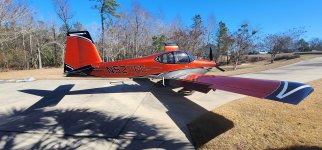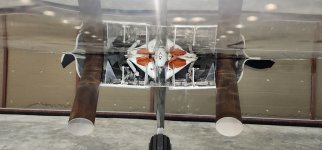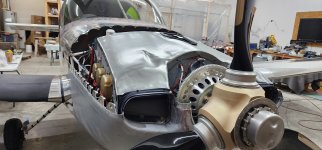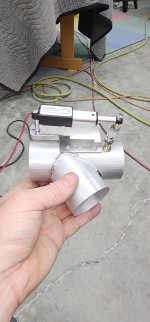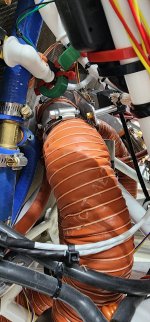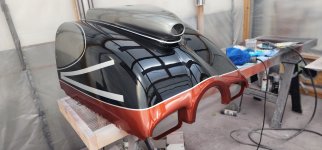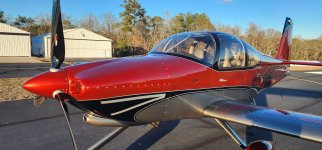Hello all. First post.
I'm having an issue with CHTs being to low in cruise. Relatively new 10, flew the 40 off last early summer, and then took 8 months to paint it. So this is my first winter, if you can call it that, flying in the south.
The aircraft has a standard cowl, but a custom built plenum that is super tight. Cowl flaps for climb.
Climb temps are normal, with #2 being my hot cylinder, and gets to about 390 in the climb at 115kts. A little cooler if I go faster. I climb at 2500rpm WOT, and start leaning above 5k. Cowl flaps are open for takeoff, and get closed somewhere around 4-5k.
Cruise is my issue, at least in winter. It seems too cold when talking with others. I'm usually running at 2200rpm WOT at around 8.5-9.5k, which, when leaned to LOP will give me sub 300 degree CHTs. If I richen it to peak, it'll run around 310-320, with at least one cylinder around 290 (#6). #5 is my hot cylinder in cruise. This is with OAT around 36 degrees at altitude. Typical cruise speed is about 172-175 TAS at around 11.2-11.4 gph around peak, closer to 10gph if running full LOP. Egts between 1350-1400. I'm running SDS and my peaks are very close, and if running full LOP I'll advance the timing to 29 degrees.
Decent is even worse. Cylinders cool to around 250, with power at 40%, 500fpm down, and 155kts indicated. Cowl flaps stay closed. My cylinders actually warm up after landing during taxi to around 300...
I use a TCW butterfly for my oil cooler to keep the oil temp up near 180, but the more I close it the cooler #6 gets.
During summer, climb temp was about the same, but cruise temps were 340-350, and the oil cooler didn't need to be damped much if at all.
So my questions:
1. How cold is too cold given oil temp is good and egts are healthily hot? I know the limits, but worry about lead buildup and sticky valves in my future.
2. If I wanted to make a servo controlled bypass hole on the baffle/plenum (say 3 inch), where is the best place to put it? Near #6 (the coldest cylinder), or #5 (the hottest)? Not much side baffle space forward of those cylinders. I may also be able to fit a 3 inch hole on the back baffle, offset towards #6.
3. Does anyone have another solution?
The engine is an older 540, with 5 chrome cylinders, one nickel, but runs like a champ. Eats a quart every 8-9 hours. It's a big investment, and Id like to treat it right.
Not the typical CHT thread, but I appreciate any input!
Roy
I'm having an issue with CHTs being to low in cruise. Relatively new 10, flew the 40 off last early summer, and then took 8 months to paint it. So this is my first winter, if you can call it that, flying in the south.
The aircraft has a standard cowl, but a custom built plenum that is super tight. Cowl flaps for climb.
Climb temps are normal, with #2 being my hot cylinder, and gets to about 390 in the climb at 115kts. A little cooler if I go faster. I climb at 2500rpm WOT, and start leaning above 5k. Cowl flaps are open for takeoff, and get closed somewhere around 4-5k.
Cruise is my issue, at least in winter. It seems too cold when talking with others. I'm usually running at 2200rpm WOT at around 8.5-9.5k, which, when leaned to LOP will give me sub 300 degree CHTs. If I richen it to peak, it'll run around 310-320, with at least one cylinder around 290 (#6). #5 is my hot cylinder in cruise. This is with OAT around 36 degrees at altitude. Typical cruise speed is about 172-175 TAS at around 11.2-11.4 gph around peak, closer to 10gph if running full LOP. Egts between 1350-1400. I'm running SDS and my peaks are very close, and if running full LOP I'll advance the timing to 29 degrees.
Decent is even worse. Cylinders cool to around 250, with power at 40%, 500fpm down, and 155kts indicated. Cowl flaps stay closed. My cylinders actually warm up after landing during taxi to around 300...
I use a TCW butterfly for my oil cooler to keep the oil temp up near 180, but the more I close it the cooler #6 gets.
During summer, climb temp was about the same, but cruise temps were 340-350, and the oil cooler didn't need to be damped much if at all.
So my questions:
1. How cold is too cold given oil temp is good and egts are healthily hot? I know the limits, but worry about lead buildup and sticky valves in my future.
2. If I wanted to make a servo controlled bypass hole on the baffle/plenum (say 3 inch), where is the best place to put it? Near #6 (the coldest cylinder), or #5 (the hottest)? Not much side baffle space forward of those cylinders. I may also be able to fit a 3 inch hole on the back baffle, offset towards #6.
3. Does anyone have another solution?
The engine is an older 540, with 5 chrome cylinders, one nickel, but runs like a champ. Eats a quart every 8-9 hours. It's a big investment, and Id like to treat it right.
Not the typical CHT thread, but I appreciate any input!
Roy



